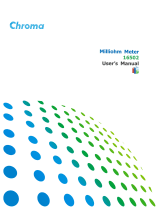The use of a four terminal measurement technique removes the test lead
resistance from the measured value although the use of lightweight current
leads may prevent the DLRO600 from producing the full requested current.
In this case the instrument will produce the highest current possible taking
into account the resistance of the current leads and the item being tested.
Before a test may be started the potential test lead contact is monitored
to ensure good contact is present. This reduces the chance of erroneous
readings and prevents arcing at the contact point, which would otherwise
damage the item under test and the test lead contacts. A resistance
measurement takes approximately 7 seconds.
DLRO600 is supplied complete with a pair of 5 metre (16 feet) current leads
terminated with large clamps, and smaller, lighter potential leads. Other
lengths and terminations are available if required.
The DLRO600 will operate with a supply voltage from 100 to 265 volts but it
will only work to full specification from 207 to 265 volts. If the input voltage
is less than 207 volts it may not be possible to obtain an output of 600 amps.
When the supply is at its lower limit of 100 volts, an output current of at least
200 amps will be possible when using the standard leads (connected to C1
and C2 terminals). If the supply voltage is low, higher output currents can be
obtained by using thicker or shorter current leads.
The large terminals C1 and C2 supply a low voltage (from zero to 5 volts)
which is adjusted automatically to produce the desired current (from 10 A to
600 A). C1 is the positive terminal. This d.c. voltage is half wave rectified and
unsmoothed, the inductance of the test leads providing sufficient smoothing
for the current.
P1 and P2 are voltage measuring terminals. P1 is nominally positive, but
connections can be reversed without affecting the measurement. All four
terminals are floating.
A warning will be given if dangerous voltages are connected to any terminal
(C or P) with respect to ground.
GENERAL DESCRIPTION
4
The Megger
®
DLRO
®
600 is an a.c. powered low resistance ohmmeter
deigned to measure d.c. resistances in the low milliohms or microhms
using a maximum test current of 600 Amps d.c. The maximum test current
available is dependent upon the power supply, the resistance of the test
leads and the resistance of the item being tested. Full details are available
in the SPECIFICATIONS section later in this book.
The power lead entry is located on the left-hand side panel and marked
“100-265 V a.c., 25 A max., 50/60Hz”. The main On/Off switch is located
next to the power lead entry. All other controls are mounted on the front
panel. Should the supply earth be inadequate the instrument will refuse
to switch on, the display will remain blank. An additional earth terminal is
provided on the left hand side of the instrument.
Principle of operation
The required current is set before the test starts. When the TEST button
is pressed, after a short delay the current increases to the set current, the
voltage detected across the “P” leads is measured, and the current then
reduces to zero.
Operation is controlled using the two-axis paddle and the menu system,
which appears on the backlit liquid crystal display. The keyboard is used
to set the desired test current and to add notes, which may be stored with
test results in on board memory for later download via the RS232 socket
provided. The measured resistance, the actual test current and measured
voltage are clearly presented on the display after the test is complete.




















